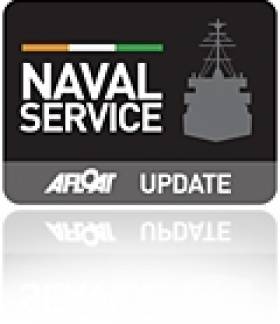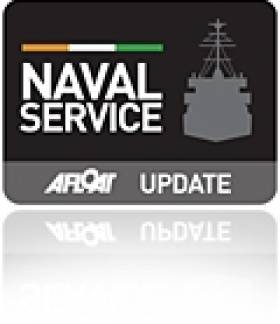Displaying items by tag: Naval Service newbuild
#EnterDryDockVideo - Afloat.ie has been informed by the Department of Defence that sea-trials of Naval Service latest newbuild OPV90 James Joyce took place between 6-9 March with delivery due shortly, writes Jehan Ashmore.
As originally reported, the trials took place in the Bristol Channel which is accessed from the estuary to where her builder's yard, Babcock Marine & Technology is located in Appledore, Devon.
After her delivery to the Naval Service, the €54m newbuild is to be commissioned in May. Likewise of her predecessor and delivery of the third and final newbuild in late 2016, the trio will feature drone technology and un-manned mini submarine capability. This will dramatically improve surveillance and incident response times.
As previously reported on Afloat.ie, the dry-docking of LÉ Samuel Beckett (P61) in Cork Dockyard last month was a pre-scheduled period and the date of entering the facility can now be revealed to have begun on 23 February.
According to the Naval Service the dry-docking was standard practice with new vessels to ensure all is well with hull fittings and the ship's capability.
The above video footage only recently published was taken from L.E. Samuel Beckett's bridge-mounted camera view that overlooks the bow of the leadship OPV90 class.
The scene shown is of the OPV departing off the Naval Base's harbour berth on Haubowline Island in lower Cork Harbour. From there she makes the short passage upriver to Cork Dockyard.
As the OPV90 heads closer to Cork Dockyard, Afloat.ie had previously reported of a blue-hulled Russian research vessel among other crafts berthed along the quayside. This vessel was the Geolog Dmitriy Nalivkin of 1,935 tonnes built in 1995 during the Soviet era at a yard in Turku, Finland.
Next we see the LÉ Samuel Beckett (P61) swing into the dry-dock, or graving dock which is 165.5m (539ft) long by 22.5m (73ft) wide and with an access width of 21.3m (70ft).
The dockyard was originally established by James Wheeler in 1853. Currently, Cork Dockyard, is a member of the Burke Shipping Group which is a subsidiary of the Doyle Group.
#OPVJamesJoyce – L.É. Aoife (P22) is on her last patrol before decommissioning and direct replacement newbuild, James Joyce is scheduled to carry out sea acceptance trials in mid-February, writes Jehan Ashmore.
According to the Department of Defence, should the second OPV90 ‘Beckett’ class proceed with sea-trials as scheduled, the newest addition to the Naval Service should make her delivery voyage to Irish waters in March.
The Department added that the formal commissioning date for the £54m offshore patrol vessel will be arranged when the ship arrives in Ireland. She is 90m in length, with a top speed of 23 knots and will have a range of 6,000 nautical miles.
As Afloat.ie previously reported, her sister leadship, L.E. Beckett (P61) undertook sea trials in the Bristol Channel prior to her delivery voyage with a first arrival to Cork Harbour last April.
James Joyce was floated-out in November from the shipbuilding hall of Babcock Marine & Technology. The yard is located on the banks of the River Torridge, Appledore in north Devon.
She is to be followed by a third sister in which no name has been chosen so far. This final OPV90 is to enter service in 2016.






























































